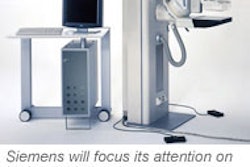Twenty-first-century mammographers are truly stuck between a rock and a hard place. Reimbursement rates, as set by Medicare, are so low that mammographers are virtually invited to cut costs by lowering quality. On the other hand, there is tremendous pressure on breast imaging facilities to provide optimal service to all women, with the most serious pressure coming from mammographers themselves.
"When we started out in our medical training, we had such high goals, and we still do in terms of the quality of the work we do. We're achieving great things with our practices," said Dr. Michael Linver during a presentation at the 2004 American Roentgen Ray Society meeting in Miami Beach, FL.
But, he added, "we are dealing with a great paradox, which is that our cost continues to rise -- due to rigorous QA/QC programs, MQSA -- and at the same time, our reimbursement continues to plummet. Medicare set a terrible precedent for all of us in terms of reimbursement. For a variety of reasons, our reimbursement continues to fall. So we are left with the temptation to compromise quality, and we know, especially in breast imaging, that this is not a solution."
Linver is the director of mammography at X-Ray Associates of New Mexico and is a clinical associate professor of radiology at the University of New Mexico, both in Albuquerque.
But all is not lost, Linver assured the categorical-course attendees. Indeed, it is possible to "make money" from mammography. The key is a strategic plan for financial survival.
Speak the language
As painful as it may seem, understanding the various codes that apply to breast imaging is crucial, Linver stressed. The main codes are:
- International Classification of Disease: Ninth Revision -- Clinical Modification (ICD or ICD-9-CM)
- Centers of Medicare and Medicaid Services (CMS) Program Memorandum AB-01-144
- Current Procedural Terminology (CPT)
- Healthcare Common Procedure Coding System (HCPCS)
In brief, ICD codes are used to determine if the services provided were appropriate for a particular medical condition. The CMS program allows radiologists to code certain findings from an exam as a primary diagnosis on the CMS claim form. CPT or HCPCS procedure codes must be submitted for payment.
Of course, just because it's coded doesn't mean that the money is automatically forthcoming. Medicare has designated acceptable ICD and CPT codes for mammography and payment rates, Linver pointed out.
The ICD code for a screening mammogram (V76.12) has been accepted universally by all regional Medicare carriers. The same cannot be said for diagnostic mammography, which has reimbursement codes that vary amongst carriers. For example, a carrier in the northeastern U.S. may accept ICD 232.5 (carcinoma in situ of the breast) for diagnostic mammography reimbursement, but one in the southwest would not. But carriers in both regions will accept ICD 232.0, which is also for carcinoma in situ of the breast.
"The payor looks at the ICD-9 code that we have submitted, compares it to the procedure we performed, and either accepts our claim as valid or denies the claim. We as radiologists must choose the appropriate code," Linver cautioned.
Squaring off against Medicare
Linver chastised the current payment system for "rewarding mediocrity," and for keeping payment artificially low. As of January 2004, the non-hospital facility global reimbursement rate for a bilateral screening mammogram is $84.01; for a unilateral diagnostic mammogram, it's $77.29; and for a bilateral diagnostic mammogram, it's $95.58.
Currently, all screening mammography is self-referred, as Medicare does not require written requisition. However, a referral from a primary care doctor (written, telephone, e-mail) is expected for a diagnostic exam -- unless the diagnostic exam is done as a result of an abnormal result on screening. In the case of the latter, which is considered further evaluation, the "GG" modifier must be attached to the CPT codes for full payment.
For full-field digital mammography (FFDM), the non-hospital facility global fee is $132.06 for bilateral screening and $140.15 for bilateral diagnostic.
For interventional procedures, Medicare has assigned a global period of zero days (19102 and 19103), so the procedures can be billed separately. Linver offered a sample of the ICD codes affiliated with a stereotactic breast biopsy procedure:
99241- Evaluation and management (E&M) consultation96095 - localization
19102 - core biopsy
19103 - vacuum-assisted biopsy
19295 - clip marker
76098 - specimen x-ray
99211 - E&M post-procedure
Linver emphasized the importance of keeping up with the vagaries of Medicare -- if not trying to stay a step ahead of them. If your practice uses a CPT code "cheat sheet," make sure that it's up-to-date. Also, follow the local Medicare review policy portion of Medicare Part B bulletins for any changes, he said.
The other players
When it comes to private payors or HMOs, Linver suggested that mammographers keep one rule in mind: "Their intent is to delay and deny payment to you."
Although most payors reimburse at the same rate as Medicare, it is not always the case. For example, many private payors are reimbursing for FFDM at the same rate as screen-film mammography (SFM), while others still consider FFDM an experimental procedure.
HMO pay rates are generally set through negotiations, and are calculated as a percentage of Medicare rates. Their rules tend to be the most convoluted of all the payors, and the most stringent -- often they require preauthorization of procedures, such as interventional ones, for example, when Medicare does not.
Currently, no payor routinely reimburses for breast ultrasound or MRI screening; preauthorization is required on a case-by-case basis.
Maximizing payback
Linver laid out the following guidelines for making reimbursement work efficiently:
Know the rules. A third of claims are rejected or ignored, most likely because of submission errors. Be sure to include all the pertinent information, including the correct patient identification, procedure, and clinical history. Make sure the findings are explained clearly.
Bill for what you do. "You can't get paid if you don't bill," Linver said.
Train personnel. If possible, designate 1-2 staff members as breast imaging billing specialists. In addition to spotting potential coding errors, these staffers can check on upcoding, incorrect billing information, or whether preauthorization was obtained.
Have a well-designed ordering pad. This should include a checklist of procedures to be performed and a diagram of the breast. Include imaging facility's contact information on the form.
Meet and greet. Remind referring physicians and staff of the importance of complying with the proper exam-ordering procedure. Also, maintain regular contact with payor personnel.
Monthly monitoring. Track important billing benchmarks (total chargers, payor mix) for unexpected changes or trends. Audit performance (callback rates, high rate of positive biopsies) so data can be used as a negotiating tool with HMOs.
Quality audits. Compile the causes for denials and claim delays periodically to determine if the problem is in-house (i.e. as a result of miscoding) or payor-related.
Rise to the challenge. Arrange to meet with payor personnel to discuss denials or underpayments. Avoid rebilling as it can result in the payor generating an adverse profile of that practice.
Linver also outlined some bad coding habits that can raise a red flag with the Office of the Inspector General:
- Items/services not rendered
- Medically unnecessary services
- Duplicate billing
- Unbundling
- Outpatient services
Finally, Linver suggested that mammographers continue to take their fight to health advocacy groups. Historically, breast cancer advocacy organizations have been able to sway legislation and have been a powerful weapon in the fight for better reimbursement, he said.
And don't forget the women themselves, many of whom are so fed up with the healthcare system that they may be interested in self-referring and paying out of pocket. Make mammography services attractive to cash-paying customers, possibly by offering a consistent discount rate. But Linver cautioned that "the discount rate must be consistent (for all patients)." In addition, co-pays cannot be waived.
"(Self-paying) patients are a dying breed, but they are not extinct. They are out there and we do need to go after them. We can charge much more reasonable rates," Linver said.
By Shalmali PalAuntMinnie.com staff writer
May 21, 2004
Related Reading
Automated claim coding pays off in time and money, May 11, 2004
Imaging reports also benefit from improved signal-to-noise ratio, May 3, 2004
Driving improvement without driving the docs away: rethinking the MQSA, May 27, 2003
Productivity is more critical than reimbursement for breast centers, February 27, 2003
E&M codes help breast centers thrive, March 26, 2002
Offensive strategy may be mammographers’ best bet in reimbursement war, October 9, 2000
Copyright © 2004 AuntMinnie.com



















